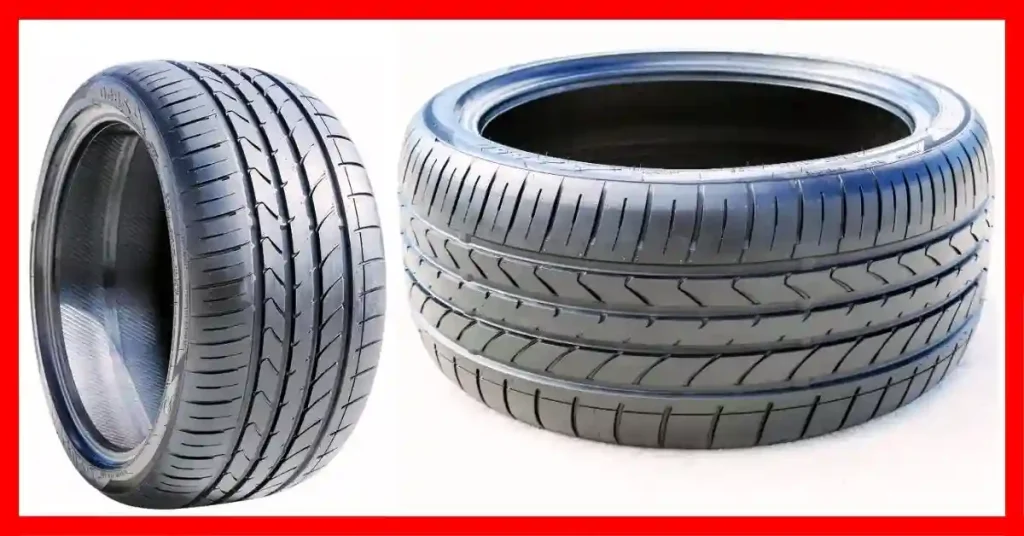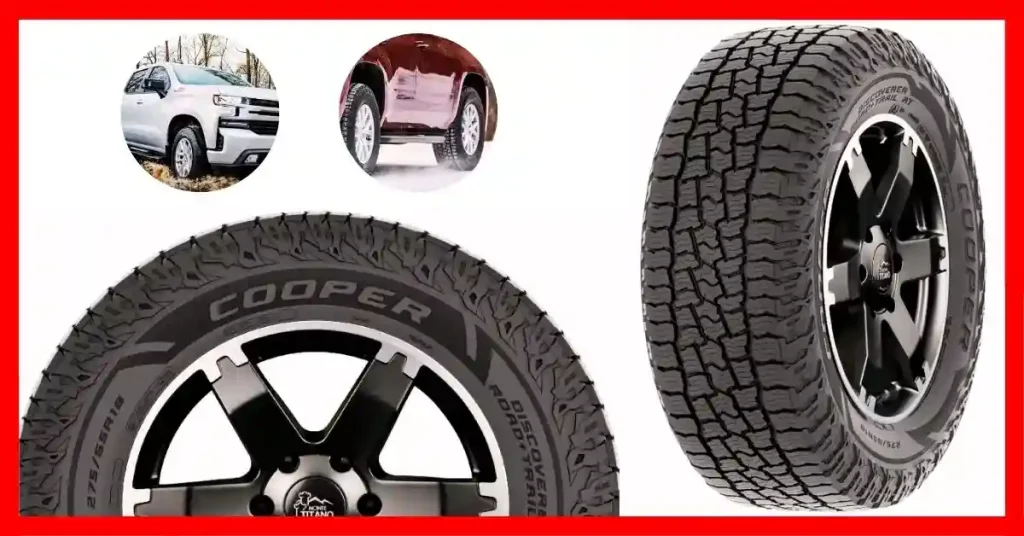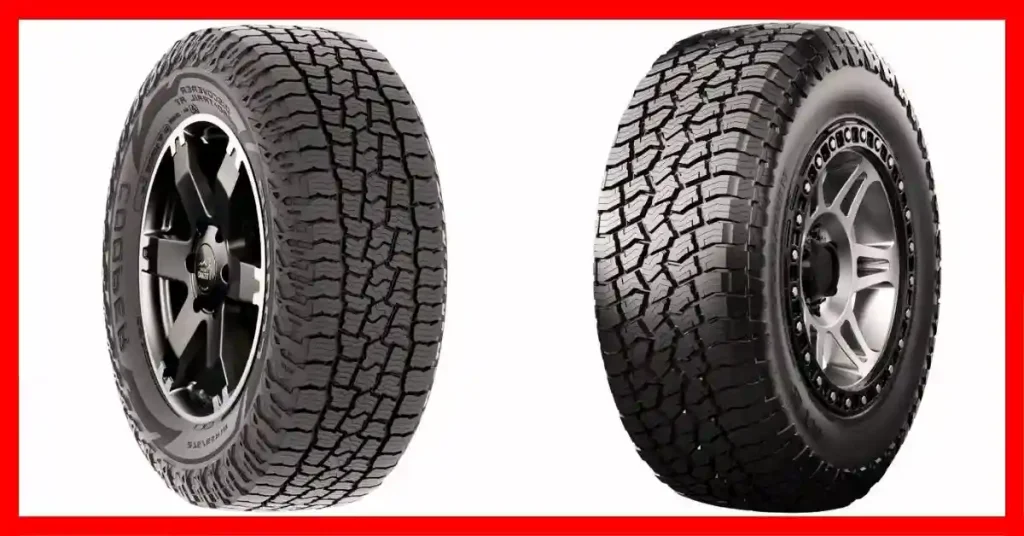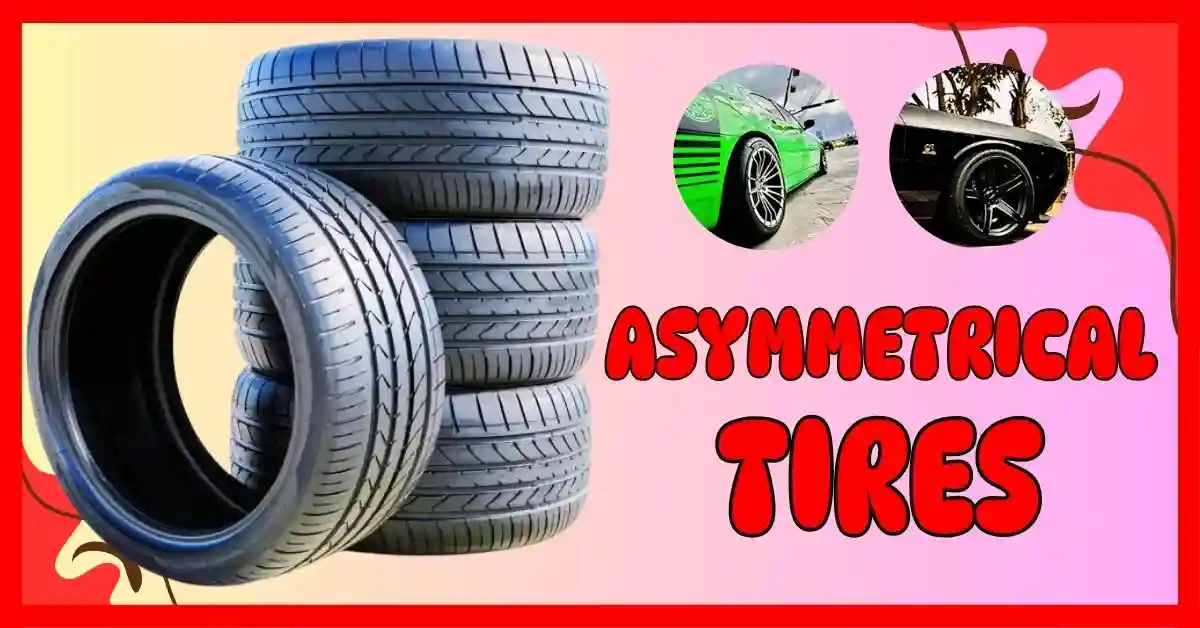Have you ever noticed that your tire tread doesn’t match on both sides? That’s no mistake. It means you have asymmetrical tires. I found this out when I changed mine and felt a big boost in grip and control. These tires use a split tread to handle wet roads and sharp turns at the same time. In this guide, I’ll explain what asymmetrical tires are, how they work, and if they’re right for you.
What Are Asymmetrical Tires?
Asymmetrical tires have a tread that looks different on each side. One side handles wet roads. The other side helps you grip better in turns. It’s a smart mix of safety and control.
You might also hear them called asymmetric tires. Same thing—just a different way to say it. So, what is an asymmetrical tire? It’s a tire with two tread styles in one. The inside helps clear water. The outside adds grip when you corner or change lanes.
I noticed the difference right away when I switched to a set. My car felt more stable in rain. On dry roads, it held turns better. I didn’t expect a tire to change how I drove—but it did.
Here’s a quick breakdown:
- Inner tread = water control
- Outer tread = cornering grip
These tires also have a label on the side. It might say “outside” or “this side out.” That tells you how to mount them. You can’t flip them or the tread won’t work right.
Asymmetrical tires work great for daily drivers, sports cars, and even some SUVs. If you drive in mixed weather or want more control, they’re worth a look.

👉🏿👉🏻 Check Latest Price and Offer at Amazon 👈🏻👈🏿
Can Asymmetrical Tires Go on Any Side?
No, asymmetrical tires cannot go on just any side of the car. They must be mounted a specific way to work as designed. The tread has an “inside” and an “outside,” and that layout matters for your grip, safety, and tire life.
I learned this the hard way years ago when a tire shop almost mounted mine backward. I caught it just in time—thanks to a small label on the sidewall that read “Outside.” That one word saved me from ruining the whole purpose of the tire.
So how do you check? Look for markings printed right on the tire. You’ll often see “Outside” or “This side out” on the outer wall. That tells the installer which side should face away from the car. If you don’t see that, take a closer look at the tread. One side will have wider blocks for cornering; the other will have grooves for water.
This matters because the inner and outer tread zones do different jobs. The inner side channels water to reduce hydroplaning. The outer side boosts grip when you take a hard turn. If you flip them, the balance is lost—and so is the benefit.
So no, you can’t just swap sides like socks. Asymmetrical tires are more like shoes: each one has a clear “left” and “right” way to wear them. Mount them wrong, and they won’t protect or perform the way they should.
What Are the Benefits of Asymmetrical Tires?
Asymmetrical tires are made to handle many road conditions. The tread on the inside is built to move water away, which helps in the rain. The outside part gives better grip when turning. This mix helps your car stay steady in both wet and dry weather. That’s what makes them so useful for everyday driving.
When I switched to asymmetrical tires on my car, I could feel the change right away. The car held the road better, especially around sharp turns. The stronger outer tread gave me more control. It felt like the car was more planted, even at higher speeds. That boost in cornering made city driving feel smoother and safer.
Another thing I noticed was how quiet the ride got. Some tires can be loud on rough roads, but not these. The tread is shaped to cut down on noise. On long trips, that small change makes a big difference. It also helps the car feel less shaky, which adds to your comfort.
I used to think these tires were only for sports cars. But they work great on regular sedans and even some SUVs. That’s what makes them flexible. You don’t need to drive fast to enjoy the benefits. If you want a tire that works well in many situations, asymmetrical tread can be a solid pick.
So, what are the benefits of asymmetrical tires? They offer better grip, smoother turns, less road noise, and can fit a range of vehicles. If you want a tire that feels balanced and safe, this design checks a lot of boxes.
Asymmetrical Tires: Pros and Cons
Asymmetrical tires are made to work well in many driving conditions. They give you good grip on dry roads and help you stay safe in the rain. That’s because the tread has two sides. The inside helps move water. The outside gives better grip when turning. This mix makes the ride feel smooth and stable.
One thing I noticed right away was how well the car handled. It felt steady in corners. I didn’t have to fight the wheel. Driving on wet roads also felt safer. The tires held the road even in light rain. That’s why people like these tires—they give solid performance every day.
Another thing I liked was how quiet they were. Some tires make noise, but not these. I drove on the highway and felt the difference. Less road noise means a more peaceful ride. It also felt smoother over small bumps. That’s a nice bonus for long drives.
But these tires do have a few downsides. If you live in a snowy area, they may not be the best. They don’t have the deep tread you need for snow and ice. I had trouble once during a winter storm. So now I switch to winter tires when it gets cold.
Rotation can also be a bit tricky. These tires have a set “outside” edge. So you can’t just swap them in any pattern. Front to back is fine, but cross-rotating only works if they are not directional. I learned this the hard way after a shop rotated mine wrong.
They can also cost more than regular tires. The design is more advanced, so the price goes up. Still, I think they give good value. You get better grip, better comfort, and more safety. For me, that trade is worth the price.
So here’s the deal. Asymmetrical tires offer good grip, smooth turns, and a quiet ride. But they cost more, can be harder to rotate, and don’t love winter roads. If you drive in mixed weather and want better handling, they’re a smart pick.
Rotating Asymmetrical Tires: What You Need to Know
Rotating asymmetrical tires isn’t hard, but you do need to follow the right steps. The most common way is simple: move the front tires to the back, and the back tires to the front. This keeps the tread wear even and helps your tires last longer. You just need to make sure the same side of the tire stays facing out.
Most asymmetrical tires have a label that says “outside” or “this side out.” That part must always face outward. If you cross the tires from left to right, the tread might face the wrong way. So unless your tires are also non-directional, avoid cross-rotation.
I learned this the hard way. A few years back, I took my car to a local shop for a routine tire rotation. When I drove off, something felt off. Turns out, they had crossed the rear tires to the front and mixed up the sides. The “outside” tread was now facing in! I had to go back and get it fixed. Since then, I always double-check or ask before the job starts.
If your tires are asymmetrical and directional, rotation becomes even more limited. These can only be moved front to back on the same side. You can’t cross them at all, or you’ll lose both grip and safety. That’s why it’s smart to know what type of tires you have before rotating them.
So, when it comes to asymmetrical tire rotation, remember this: front-to-back is safe, cross-rotation is only okay if they’re not directional, and always keep the “outside” label facing out. Done right, your tires will wear evenly and perform at their best.

👉🏿👉🏻 Check Latest Price and Offer at Amazon 👈🏻👈🏿
Are Asymmetrical Tires Directional?
No, asymmetrical tires are not always directional. The two terms sound alike but mean different things.
Asymmetrical tires have tread patterns that are not the same on both sides. The inner part helps grip wet roads. The outer part gives better control in turns. That’s why they must be mounted with the “outside” side facing out. You’ll see that word on the tire.
Directional tires are made to roll in only one direction. The tread often looks like a V or arrow. These tires have an arrow on the side that shows which way they should turn. This design helps push water away when driving fast on wet roads.
If a tire is both asymmetrical and directional, you have to be extra careful. You must match both the outside and the rotation arrow. But most asymmetrical tires are not directional, so front-to-back rotation is fine.
Think of it like shoes. Some have a left and right foot. Some only point one way. If you wear them wrong, they just don’t feel right. Tires work the same way.
So, are asymmetrical tires directional? No, most are not, but check the sidewall before mounting or rotating them. One small detail can make a big difference in how they perform.
Asymmetrical vs Symmetrical Tires: What’s the Difference?
All tires look round. But they’re not all the same. Some have different tread patterns on each side. Those are called asymmetrical tires. Others have the same tread all the way across. Those are symmetrical tires.
Symmetrical tires are simple. The tread is even from edge to edge. They are easy to rotate. You can move them front to back or even cross them. I had these on my old Civic. They were quiet and smooth. No fuss, just drive.
Asymmetrical tires are a bit smarter. The inside tread helps with grip in rain. The outside helps when you turn. I used a set on my Mazda 3. They felt firm in corners. And in wet weather, they held the road well.
Here’s the short answer:
- Symmetrical tires are good for calm driving. They’re easy to use and cheap.
- Asymmetrical tires are better for grip and control. They cost more but give you more feel.
Think of shoes. Symmetrical tires are like flat sneakers. Easy and comfy. Asymmetrical tires are like training shoes. Still comfy, but with better support when you move fast.
Asymmetrical vs Directional Tires: Key Differences
Not all tires are the same. Some roll one way. Others care more about which side faces out.
Directional tires roll one way only. Their tread looks like an arrow. This helps push water away. It keeps you safe in the rain. I had these on my car one summer. They felt sharp and sure, even in big puddles.
Asymmetrical tires have two tread zones. One side grips the road in wet spots. The other helps with sharp turns. They can roll either way. But they must face the right side out. I made this mistake once—it cost me a trip back to the shop.
Here’s how they compare:
| Feature | Asymmetrical Tires | Directional Tires |
| Tread Look | Two zones, in and out | Arrow or V-shape |
| Mounting | “Outside” must face out | Must roll one way |
| Wet Grip | Very good | Great |
| Rotation | Front to back is fine | Front to back only |
| Best Use | City, dry, and some wet roads | Rain and high-speed roads |
| Ease of Use | Easy if mounted right | Can be tricky to rotate |
So which is better? It depends on your needs.
Go with directional if rain is a big deal where you live. They keep you safe when roads are wet. Go with asymmetrical if you want grip in more spots. They work well in sun or rain.
Think of it this way:
Directional tires are like swim fins—made for one job.
Asymmetrical tires are like sneakers—good at many things.

👉🏿👉🏻 Check Latest Price and Offer at Amazon 👈🏻👈🏿
👉🏿👉🏻 Check Latest Price and Offer at Amazon 👈🏻👈🏿
My Real-World Review of Asymmetrical Tires
I used to think all tires were the same. I was wrong. Asymmetrical tires changed how my car feels on the road.
I put Michelin Pilot Sport All Season 4 on my Mazda. The tread looked odd at first. One side had big blocks. The other side had more lines and grooves. But once I drove on them, I could feel the difference.
On dry roads, the tires felt firm. I could turn fast and stay in control. The grip was strong, but the ride stayed smooth. My car felt more fun to drive.
Then it rained. I was nervous at first. But the tires pushed water away fast. I didn’t slide. I didn’t lose grip. Even at high speed, the ride felt safe.
In the city, they were great too. Stops were smooth. Turns were tight. They didn’t make much noise. That was a big plus for me.
Here’s what I learned: asymmetrical tires are good in dry and wet weather. They help you turn better. They also feel nice and soft on the road.
Would I buy them again? Yes. If you want better grip, safe rain driving, and a quiet ride, these tires are a smart pick.
Just check that the right side is facing out. That’s key. Once they’re on right, you’re set.
FAQs About Asymmetrical Tires (Answer Engine Optimized)
Q1: What do asymmetrical tires do?
They help you drive better in both wet and dry roads. The inside part pushes water away. The outside helps with grip and turning. I felt the grip right away when I hit a wet curve—it felt safe and smooth.
Q2: Are asymmetrical tires directional?
Most of them are not. But you must still mount them the right way. Look at the side of the tire—it should say “outside” or “this side out.” One time, a shop almost got mine wrong. Good thing I checked first!
Q3: How do I know if my tire is asymmetrical?
Look at the tread. One side will look different from the other. You’ll also see words like “inside” and “outside” on the tire. I noticed this during a car wash and looked it up—it was a cool find!
Q4: Can I rotate asymmetrical tires?
Yes, you can move them from front to back. Just don’t crisscross them unless they are also non-directional. I once got a mix-up with this. The shop had to redo it. Since then, I always ask before rotating.
Q5: Are asymmetrical tires worth it?
If you want better grip and handling, they are. I use them on my daily car, and I love how they feel in rain or sharp turns. For me, they were a smart buy.
Conclusion: Are Asymmetrical Tires Right for You?
Asymmetrical tires are a smart pick for most drivers. They give you better grip, smooth handling, and more control in wet or dry weather. They are built to handle both sharp turns and sudden rain. That mix makes daily driving feel safer and easier.
But they’re not perfect for everyone. If you deal with snow or ice often, winter tires are a better fit. The best tire depends on where you drive and how you drive. Think about your weather, speed, and roads.
For me, the change was clear. Once I switched to asymmetrical tires, my car felt tighter in corners. Wet roads didn’t feel as scary. I didn’t expect a big change—but I got one. If you want safety and comfort, these tires are worth a look.Here’s a quick tip: check your tires. Look for the words “inside” or “outside” on the sidewall. Your next set of tires might be smarter than you think.
To Get More About Car Accessories Product You Can Visit Our Site. If You Found our Posts Helpful Leave a Comment Below

